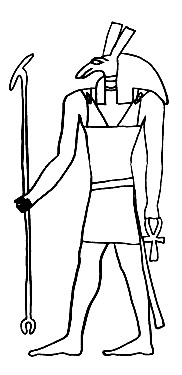
ست هو رب الفوضى والارتباك. وكان ست ابنا للرب جب والربة نوت؛ وشقيقاً بالتالي لأوزوريس وإيزيس ونفتيس, وزوجاً للأخيرة (نفتيس). ووفقاً لبعض الأساطير قتل ست شقيقة أوزوريس, ودخل في معركة مع حورس ابن أوزوريس؛ في صراع على العرش, وأيهما يصبح الملك. وكان القتال بينهما عنيفا أحيانا. وحاول حورس قتل ست برمح, ولكن ست تحول إلى برنيق أو فرس النهر ومزق عين حورس. وحسم الصراع, في النهاية, من خلال محكمة إلهية جاء قرارها في صالح حورس. وأرجعت حالة الفوضى خارج وادي النيل والأقطار الأجنبية إلى ست؛ ولهذا ارتبط اسمه أحيانا بربات أجنبيات. مثل الربتين "عشتارت وعنات". ومثل معظم الآلهة كان لست أيضا جانب إيجابي مفيد؛ فهو مثلاً, من يهزم الأفعى الشريرة أبوفيس (عابب) أكبر أعداء إله الشمس رع في كل ليلة. وكان ست يعبد منذ عصور ما قبل التاريخ, كما يتبين من حقيقة تصويره على كافة أنواع القطع الأثرية من تلك العصور. ولم يكن ذلك هو الحال فقط مع حضارة نقادة التي تقول الروايات بأنها كانت موطن مولده؛ وإنما في جميع أنحاء مصر. وكان كل ملك في مصر يعد تجسيداً لكل من حورس وست, وكانا يصوران معاً في كثير من الأحيان؛ مثلاً على جانبي العرش, في مشاهد ترمز إلى توحيد القطرين. وحظي "ست" بتكريم خاص خلال عصر الانتقال الثاني, حيث كان يعبده الهكسوس في الدلتا (ربما نتيجة ربطهم له, مع ربهم" بعل", وكذلك أوائل زمن الرعامسة الذين حمل بعض ملوكهم اسمه (مثل سيتي الأول). ويصور "ست" عادة في شكل إنسان برأس حيوان أسطوري يشبه الحمار أحيانا, أو آكل النمل. كما صور ست أيضا في شكل حيوان؛ بجسد حيوان وحشي أو غير ذلك من الثدييات, وبنفس رأس الحيوان الأسطوري الدال عليه مع ذيل مفروق مرفوع. وهو يظهر كذلك في شكل أنواع مختلفة من الحيوانات التي تختلط المشاعر حيالها؛ مثل البرنيق أو فرس النهر والخنزير.